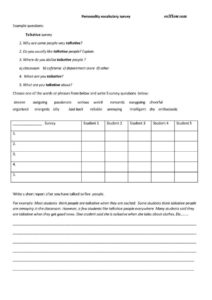Personality Adjectives/Vocabulary and Listening/Speaking Activities
16th February 2025
A wide range of teaching activities are useful for teaching the vocabulary of personality including: vocabulary-picture matching, personality surveys, word sorting exercises and role plays.
Describing a Businessman (with answers)
This is an ESL exercise for practicing the use of adjectives that might be useful for describing a businessman’s personality and behavour. Students match the adjectives to the pictures and if possible, try to make a sentence explaining why the adjective matches the picture.
Adjectives for a businessman (PDF)
Subscribe to Eslflow
Stay at the forefront of language teaching innovation!
✅ Full access to the latest complete exercises with answers
✅ Ad-free, high-quality content delivered straight to your inbox
✅ Regular updates for the latest topics
✅ Exclusive insights on cutting-edge AI advancements in education
Personality Adjectives for Friends – listening and speaking (with audio and answers)
This is a listening/speaking exercise for personality vocabulary for describing friends and colleagues. Students listen to the audio and match the appropriate vocabulary to the pictures. The audio is a picture/conversation matching exercise. The video is a simpler vocabulary/matching exercise.
Personality vocabulary for friends (PDF)
(see the YouTube video of this activity)
Create a Conversation: Personality
Writing a conversation exercises work really well for some topics and personality is one of the best. This works best with lower level students of course, but with advanced students you have to encourage them to build on their ideas.
Write a conversation: personality(PDF)
First Impressions (woman)
This is a listening/speaking exercise for English language learners to talk about personality and first impressions. This exercises focuses on a woman. Students look at the pictures and try to create a story about how they got to know this man.
First Impressions (man)
This is similar to the exercise above. This exercises focuses on a man.
First impressions 1 (man) (PDF)
Elementary Personality Vocabulary and Speaking
Nearly all the words used to talk about personality are adjectives. This makes it quite easy to teach. The only problems I have with elementary personality vocabulary are the words “fun” and “funny”. My students often use “funny” when they should be using “fun”. And then there is the problem of “fun” often being used as a noun. But other than that….teaching the language of personality is …a lot of fun!
Elementary personality vocabulary(PDF)
Related Resources:
4 romance, love and friendship lessons (PDF)
5 Intercultural Body Language, Gestures and Etiquette Language Exercises
6 More Advanced Personality Vocabulary and Speaking
The range of personality vocabulary becomes almost infinite the more you look into it. Here is a selection of more advanced vocabulary which can also serve as a pronunciation exercise for better students. Many students have problems with words such as “enthusiastic” and “conscientious”. And other words that are tricky for some students include “weird” and “suspicious”.
More advanced personality vocabulary(PDF)
7 Parts of Speech: Personality
When you look at the grammar of personality, it is quite interesting that most of the words are adjectives. But it is worth helping students get to know the noun forms of these adjectives too.
Parts of speech for personality(PDF)
Related Resources
Comparative Adjective Exercises and Worksheets
10 Jobs and Careers Language Skills Exercises
6 Describing People and Appearance Vocabulary and Language exercises
10 Role Play Speaking Activities
7 Essential Speaking Activities for ESL Classes
3 Great Icebreakers to Start a Class
Elementary Personality Interview Speaking Lesson
This is an ESL speaking lesson for talking about personality. Students interview each other using the questions on the handout. They also ask for examples of each personality trait. Then they choose a job for the interviewee based on the answers they receive.
Personality interview speaking exercise (PDF)
Personality adjectives dictation and other exercises
This is my favorite all-purpose and sustainable (ie. it never gets old and can be repeated endlessly – you just need new vocabulary and new pictures) teaching exercise . It’s a listening exercise, a vocabulary exercise and it’s suited to every size of class. It can be used to introduce vocabulary. It can be used to review vocabulary.
Personality adjective and vocabulary exercises (PDF)
Personality vocabulary positive/negative sorting
In this vocabulary exercise students have to decide whether the personality adjectives are positive, negative or if they are sometimes positive and sometimes negative depending on the situation.
Personality vocabulary sorting (PDF)
Personality vocabulary survey and speaking lesson
This is an ESL speaking and writing lesson for talking about personality. First, each student chooses one adjective. Then they write five survey questions that adjective. There are some examples of questions at the top of the first page of the PDF. When they have written five questions, they can walk around the class asking classmates their questions and noting down their answers on the worksheet. Finally, they write a short report from their survey question answers. This is a fun communicative exercise that allows students to mix freely.
Leadership potential interview/questionnaire (more advanced)
Students interview a classmate about their leadership potential and write their opinions at the bottom of the page.
Leadership potential questionnaire (PDF)







